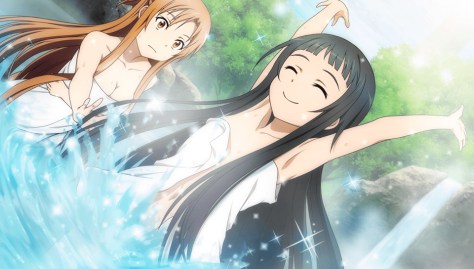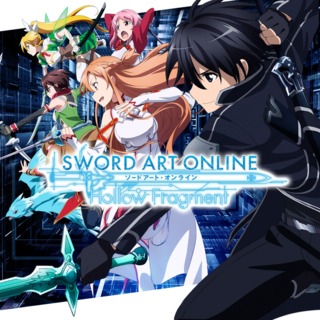
/!\ Caution! This review contains spoilers for the Sword Art Online anime /!\
Sword Art Online Hollow Fragment (SAOHF) is the second game inspired by Reki Kawahara’s light novel, but the first one to reach western shores. Don’t worry though, because you won’t miss anything : the first game, Sword Art Online Infinity Moment, is included in SAOHF, the latter being in fact an extension of the former.
For those who are familiar with the chronology of SAO, Hollow Fragment starts when Aincrad ends. It’s at the same time an extension and an alternative ending to the first part of the anime. After beating Kayaba Akihiko at floor 76, the game doesn’t end. So Asuna, Silica, Lisbeth and all the SAO players have to climb to the 100th floor. Meanwhile, Kirito finds himself transported in some unknown area, called Hollow Area. Seconds after he arrives, he is attacked by a Player Killer called Philia. SAOHF is therefore composed of two distinct parts, Aincrad as we know it from the anime/LN and the Hollow Area especially thought and designed for this new Vita game.
Before we go into the differences between them, let’s check the battle system. You always play as Kirito, while having in your party a girl (or a man, for that matters) controlled by the AI. The game mechanism is close to Xenoblade’s in the way there’s an auto-attack and cooling down when you use some skills. During battles, you have five palettes that you can switch between with L and R. Two are for giving instructions to your partner (retreat, defense, offensive, congrats, etc.), one regroups your attack skills and the last two your healing/support magic. Your partner will regularly ask you to perform certain actions (attack skill, switch, paralyze the enemy) by which both characters will launch a powerful joint attack or relay. You also have to watch a «risk» gauge : the higher, the less effective your normal attacks will be. You therefore have to ask your partner to «switch», which sends her/him on the front without cover, but recovers the risk.
While it seems attractive on the paper, the execution is not always good. The IA of the girls tend to ignore the situation time to time, stopping for no reason or ignoring your switchs. But the biggest concern about them is that they are fairly weak at the beginning of the game. For example, Kirito starts at level 100, Silica only at lvl 70. They naturally reach Kirito’s level as you progress in the game, but it causes lots of irritating game over in the first hours. Furthermore, most of the fights can be done with only pushing the circle button and waiting for some sign from your partner. You’ll have to wait to have at your side partners at respectable level and in front of you some really though enemy if you want to experience the thrill of battle like it was thought by the devs. Technically speaking, the game is not even average : the 3D are neither that good nor that bad, animations are kinda stiff, and the game has quite a few annoying frame rate drops and graphics bugs.
Let’s examine Aincrad now. Climbing your way to the 100th floor feels a bit humdrum : at every floor you’ll have to complete unappealing sub-tasks while in search for the boss’s room, and then beat the boss itself. The level design is nothing special, the floors look like each other too much. True, it’s pretty large in total, but most of time you’ll be going from point A to point B. There is no proper «exploration» and puzzles are scarce.
You can still spend a bit of time with your harem for a change, sitting at the café with whoever you want to have a little chat. That said, the dates are nothing exciting because there are precious few topics and the answers are completely random. There is no logic to infer like you would you do in a real dating sim.
Fortunately, the game includes a lot of events really close to the anime in terms of humor and atmosphere. And when I say a lot, it’s nearly a dozen per floor, with sometimes sub-quests that will make you go back looking for special things in previous floors. Those are actually mini-stories detailing the situation between Kirito and the girls (in Asuna’s case, it’s about their marriage). Events are a LOT more focused on fan-service than the anime’s average, which you can easily figure out from the numerous beautiful and juicy illustrations. Let’s stress that SAOHF includes Leafa and Shinon (who don’t appear in Aincrad, Shinon having for example premiered recently in the second season airing right now), and two original characters, Philia and Strea. It’s quite a noticeable bonus for the fans of the series and adds some variety too.
But SAOHF doesn’t stop here in variety. After a certain time, you will actually be able to pick any NPC as your partner! They will regularly ask you to come and fight alongside them to help raise their level. By doing this, you will gradually earn the trust of all the characters around you. Not only that, but this has also an influence on boss battle, because some NPCs will always join you in your attempts to clear a floor.
Even though I highly recommend to clear Aincrad first, nothing stops you from jumping in the Hollow Area right away, or even to do both parts in parallel for a change. SAOHF in not linear at all for that and you can manage your progression as you like. The Hollow Area is organized very differently from Aincrad : it’s a very large surface divided into smaller areas you to clear one after another. The comparison with Xenoblade is clear, «exploration» becomes the keyword. Navigating is pretty tricky as the rough map you have at your disposal is about as precise as a pirate’s treasure map, and just going trough a couple of zones takes hours. The game helps out a bit but not too much, which leaves you really searching your way forward and think like you should always do in a correct JRPG. Note that the environments are a lot more refined, and level design improves quite significantly too.
Battles had become increasingly intense in the last stages of Aincrad, but here in the Hollow Area, they’re pure enjoyment. This is thanks to several things, the first being the thunderous boss battle theme that makes confrontations tremendously dynamic. The second thing is the perfectly balanced difficulty, which makes battles really rewarding. You have to be constantly swapping between palettes and item list, and at the same time having an eye your your partner’s situation. And believe me, the boss monsters’ design is something…
Third thing is the scenario. While the story in Aincrad only begins in the upper floors (and actually merely copies what happens in Fairy Dance), the story that takes place in the Hollow Area is full of original and clever ideas, with some moments easily matching the best parts of the anime. The cutscenes are of really good quality (as good as in Fire Emblem Awakening for instance) and really help building a fascinating atmosphere. The sad thing is that it’s quite shorter than Aincrad : I rushed it within 20 hours, while spending more than 50h to clear Aincrad. But I still have trophies to get and a bunch of sidequests left untouched, so I could probably spend a extra couple of hours in it if I hadn’t that big pile of games to finish and review ^^’
No doubt that Sword Art Online Hollow Fragment will provide some great entertainment to SAO fans. However, because of its various drawbacks, it might not be good enough for JRPG players at large.

